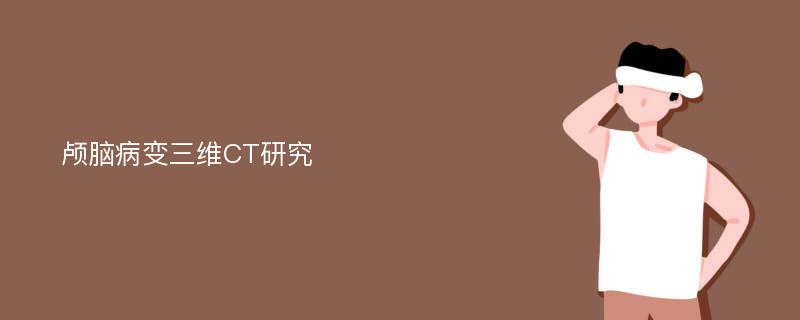
范亚[1]2011年在《基于高分辨率颅脑CT体数据的病变自动检出方法研究》文中研究指明With further development of the computer technology, image processing, pattern recognition and artificial intelligence technology, the whole society is becoming more intelligent. In the medical field, a variety of high-capacity, high-resolution medical imaging equipments are applied. In a medium-sized hospital, the growth rate of CT scan images produced by a variety of medical instruments is more than 10G byte per day. Doctors have to do a lot of diagnosis facing computer screen or films every day. As a result, the efficiency improvement of large-scale usage of inspection equipments is not obvious, and it may lead to unnecessary misdiagnosis and missed diagnosis. The traditional manual way of reading film imags has significantly lagged behind the rapid development of technology and equipment, and with the growing application of greater capacity, higher resolution, more advanced imaging equipment, this contradiction will become increasingly prominent.Medical image is a kind of natural image and has the features of structural continuity, and grayscale consistency in CT images et. al. Theoretically it can be machine identified using image processing technologies and pattern recognition technologies. In long term, to carry out intelligent computer-aided diagnosis based on image processing and analysis will become a major trend. In order to achieve the goal of computer intelligent diagnosis or computer aided diagnosis, the problem first of all must, thus, be faced and solved is automatic detection of lesions. Nowadays, lesion detection based on whole brain scan data especially detection based on texture features is just in the beginning. In this dissertation, aim at the direction of computer intelligent diagnosis, and intensive studies lesion detection methods based on high-resolution 3D cerebral CT images, we put forwards several innovative algorithms or improvement algorithms. Experiments are performed to verify the overall framework and algorithms we proposed. The main research work and contribution of this dissertation are as follows:(1) Proposed the main framework of lesion detection based on three-dimensional cerebral CT data.Currently, lesion detection based on three-dimensional CT volume data is still in the initial stage, there is no unified framework and standards. This paper presents a lesion detection method based on three-dimensional cerebral CT data and feature vectors statistical atlas, and the flow chart and main framework of lesion detection, including data preprocessing, rigid registration and non-rigid registration, atlas creation, feature extraction, and, ultimately, the process of disease detection. We also have done experiments in every stage to verify the methods and the main framework.(2) Proposed a whole brain image segmentation method based on prior knowledge and the continuity of the brain structure, and also an interpolation algorithm in layers.Based on the prior knowledge of cerebral CT images and the continuity of brain structure, we proposed a whole brain image segmentation method which begins from the centure layer and respectively to the base and top of the skull, and it can automatically segment the whole brain images in one time. This dissertation proposed an improved inter-layers interpolation algorithm, which should select a neighborhood window, and then select corresponding point from neighborhood window based on feature vectors. Experimental results show that the proposed method satisfied the interpolation constraints, the image interpolated has clear structure, and retains the structural characteristics and textural properties, and meets the requirement of subsequent data processing.(3) Proposed an improved rigid registration algorithm, to avoid falling into local optimal solution.As Powell optimization algorithm is a local optimization algorithm, it is easy to fall into local optimal solution. In addition, the characteristics of the image itself and the local similarity caused by interpolation are also easy to make the registration process fall into a local optimum. In this dissertation, we proposed an optimization algorithm based on uniform design and Powell. The experiments verified that it can avoid falling into local optimal solution.(4) Proposed the improved Demons algorithm to strengthen the topology preservation of registration.The existing research results can not completely eliminate the non-topology preservation in non-rigid registration. So, we designed an improved algorithm. This is based on the viewpoint that it's not only necessary to reduce the deformation, but sometimes to increase the deformation for topology preservation. In this algorithm. we maintain the direction of deformation and make two-way optimization of deformation magnitude to make the Jacobian determinant greater than zero. Experiments verified that the improved method can eliminate all deformation points without topology preservation.(5) Proposed a texture feature vector construction method for building statistical mapping and lesion detection.In order to detect lesions with texture features, a texture feature vector with low-dimension and high classification capacity should be constructed. In this dissertation, we proposed several optional texture characteristics based on theoretical analysis, and then do experiments to select the best combination. Experiment verified that the lesion detection result is fine based on the selected texture feature vector. Compared to other high-demension feature vector, it has the features of simple construction, less calculation and good texture classification capacity.We appreciate the support of Nature and Science Foundation of China (Project No.60771007).
谢代军, 康安发, 阮杰, 吴堡[2]2016年在《CT血管成像技术在颅脑病变诊断中的价值分析》文中研究指明目的:探讨CT血管成像技术在颅脑病变诊断中的价值,指导临床选择合适的治疗方案,提高临床对该类疾病的治疗效果。方法:选取2012年7月到2015年5月166例颅脑病变患者为研究对象,所有患者均予多平面重建、曲面重建、最大密度投影和三维容积重建等技术显示颅脑血管,对颅脑血管显示情况进行评价,将其诊断结果和手术病理结果进行对比。结果:166例患者CTA显示有80例患者为脑动脉瘤,增强后血栓处不强化,动脉瘤直径为2~15mm,其中长囊袋状有5例,呈带蒂囊状9例,瘤体瘤颈分界不清的有4例。4例为静脉畸形,CTA清晰显示异常静脉,70例为脑梗死,CTA显示脑动脉管腔狭窄和闭塞,4例为烟雾病,3例为颈动脉海绵窦漏,5例脑梗死;166例患者术后病理检测结果与CTA诊断结论一致。结论:CT血管成像技术能显示出颅脑病变的各种血管病变,价值肯定,优势明显。
宦怡, 郭庆林[3]1994年在《颅脑肿瘤三维CT的临床应用》文中研究说明本文通过对93例颅脑肿瘤病人的三维CT(3DCT)研究,发现①3DCT能生动地显示肿瘤的大小、形态、位置及与周围大血管、脑室、小脑幕及大脑镰的立体解剖关系,②能各角度旋转及切割观察,并可进行解剖测量。本文还就其优越性及限度做了探讨。
孙涛[4]2009年在《基于特征向量的二维颅脑CT图像配准与分割》文中研究说明随着医学影像技术的飞速发展,包括多排螺旋CT在内的先进的成像设备开始在临床上广泛使用。它们产生的影像资料清晰度越来越高,数据量也越来越大,一方面为影像医师提供了更清晰的医学图像,但另一方面也给他们带来了很大的读片负荷。在此背景下,计算机辅助诊断成为解决此问题的一个有效途径。在颅脑病变的检查中,许多MRI图像难以应用的场合,高分辨率CT图像是一种十分重要的替代手段,针对脑出血和脑肿瘤等病变更是具有自己独特的优势,具有不可替代的地位。开展基于颅脑CT图像的计算机辅助诊断的研究,需要针对CT图像的特点研究诸如特征提取、图像配准和图像分割在内的一系列相关的技术。本文利用医学图像纹理分析技术提出一种基于局部直方图的几何不变矩。通过提取不同尺度下的局部直方图,计算能够反映图像纹理特征的几何不变矩,并融合了图像像素的边界信息,为图像中的每个像素建立了属于其自身的特征向量作为其形态学签名。实验证明,特征向量将图像的灰度信息映射到特征空间,从而增大了属于同一组织的像素的相似性和分属不同组织的像素的差异性,具有良好的纹理特征区分性能。在实现计算机辅助诊断的研究中,图像的非刚性配准是关键的一步。本文利用具有相同解剖位置的像素的特征向量的相似性,实现了对应特征点的自动搜索和准确定位,解决了基于特征点的非刚性配准算法需要手动选择标志点的问题。更进一步,利用基于特征向量的对应特征点自动搜索算法的良好性能,通过将特征提取与近似薄板样条非刚性配准相结合,提出了一种特征向量驱动的颅脑CT图像配准算法。该配准算法保证了颅脑CT图像上具有关键解剖意义的点的一一对应,不仅适用于正常图像的配准,而且也适用于病变图像的配准。图像分割在基于数字化图谱的病变检出中,是一种重要的定量分析手段。特征向量具有良好的组织区分能力,能够区分出颅脑CT图像上分属不同组织但具有相似或相同灰度值的像素。用改进的模糊C均值聚类的方法将特征空间的点聚集成对应不同组织区域的类团,并将分类结果映射回图像空间,在颅脑CT图像颅内空间的组织分割中取得了良好的效果,能够分割出完整的白质、灰质和脑脊液。课题研究工作的成果较好的实现了计算机辅助诊断研究中所需的特征提取、非刚性配准和图像分割等技术,具有实际应用价值。本论文的工作得到了国家自然科学基金项目(60771007)的资助。
周平[5]2007年在《基于纹理特征的颅脑CT图像病变自动化检出算法研究》文中认为随着医学影像技术的飞速发展,包括多排螺旋CT在内的先进检查设备产生的影像数据清晰度越来越高,容量也越来越大。海量的容积数据在为影像诊断医师提供更加详细、更加准确的诊断信息的同时,也显着增加了读片医师的工作负担和视觉疲劳。传统的人工读片方式与越来越先进的检查设备之间的矛盾随着这些设备的不断普及应用而变得日益突出。为了适应医学影像检查技术的飞速发展,开展以计算机辅助诊断或计算机智能化诊断为目标的医学图像处理和分析研究已经成为目前这个领域的一个研究热点和将来发展的主要趋势。开展计算机辅助诊断和智能化诊断研究首先必须解决的问题是如何实现医学图像上病变的计算机自动化检出。病变的自动化检出又必须涉及到图像配准,图像分割,数字化图谱创建等多项基本的图像处理和分析技术。本文瞄准计算机智能化诊断这个方向,以多排螺旋CT扫描的颅脑CT图像为研究对象,以颅脑CT图像的纹理信息为研究切入点,以颅脑病变的自动化检出为研究目标,通过密切结合医学专业知识,对病变检出及其相关技术进行了深入的研究,取得了多项具有创新意义的研究成果。具体成果和创新点介绍如下:1.提出了以颅脑CT图像的纹理特征作为病变自动化检出的依据,研究并构造了一种基于树结构小波变换的纹理层析向量,用于描述颅脑CT图像特征解剖部位的纹理特征。本文在研究各种病变的计算机自动化检出算法的基础上,发现目前的病变检出算法很少重视图像的纹理信息。纹理描述了图像象素间的相互依赖关系;小波变换作为多尺度、多通道的分析工具,为纹理信息在不同尺度上的分析和表征提供了精确、统一的框架,应用小波变换算法构造的纹理层析向量可以有效的描述图像的纹理信息。据此本文研究并构造了一种基于树结构小波变换的纹理层析向量。实验结果表明,这种纹理层析向量鲁棒性强,且具有唯一性、平移不变性,并在一定范围内满足旋转不变性,可以有效的描述图像的纹理信息,为本论文后面的研究工作奠定了基础。2.针对基于特征的非刚性配准算法,提出了一种基于纹理层析向量的对应标志点的自动搜索算法。非刚性配准技术是实现病变检出的核心,本文在深入研究各类非刚性配准技术的基础上,针对基于特征的非刚性配准算法需要手工介入,无法实现完全自动化的缺点,提出了一种基于纹理层析向量的对应标志点搜索算法。本文通过在待配准的颅脑CT图像内自动搜索与目标图像具有相似纹理区域的标志点,实现了对应标志点的全自动搜索。实验结果证明,这种对应标志点的自动搜索算法标记正确率较高,可以解决基于特征的非刚性配准算法需要手工介入的问题。3.提出了一种新型的数字化统计图谱——纹理层析向量图谱,并实现了颅脑CT图像纹理层析向量图谱的计算机自动化创建。正常图像主要是通过数字化统计图谱进行计算机描述,本文在研究了现有类型的数字化统计图谱后,为弥补现有类型图谱在描述正常人图像纹理特征方面的不足,利用前面有关纹理层析向量的研究结果,提出了基于纹理层析向量的颅脑CT图像的数字化统计图谱的构造算法。本文成功的实现了二维颅脑CT图像的纹理层析向量图谱的计算机自动化创建。纹理层析向量图谱描述了颅脑CT图像的纹理特征。4.应用颅脑CT图像的纹理层析向量图谱,实现了对钙化、脑出血等病变的计算机自动化检出。由于大多数病变的影像学表现为图像的纹理变化,因此本文从分析图像的纹理信息入手,利用前面创建的颅脑CT图像的纹理层析向量图谱,通过比较待诊断图像各个区域的纹理层析向量与图谱间的差异,实现了对钙化、脑出血等病变的计算机自动化检出。
时玉春, 陈淑宽, 张海豹[6]2018年在《CT血管成像技术在颅脑病变诊断中的临床价值分析》文中指出CT作为临床广泛应用的诊断技术,不仅具有无创、便捷等优势,还能通过对血管信息的表达帮助临床诊断。而CT血管成像技术则结合了CT增强扫描、快速扫描等技术,使扫描范围进一步扩大,并能多层扫描,后期还能通过对图像进行三维成像处理来全方位深度反映血管细节,为各类血管病变的临床诊断提供高价值影像学资料~([1])。本研究中,笔者将其应用于颅脑病变患者,着重分析CT血管成像技术在颅脑病变
刘昌盛, 魏文洲, 郑晓华, 童世平, 殷响林[7]2004年在《低剂量CT扫描对婴幼儿颅脑病变的诊断与防护价值》文中研究表明目的 探讨低剂量CT扫描技术在婴幼儿颅脑病变检查中的临床应用与防护价值。方法 对高度怀疑颅内病变的婴幼儿患者 36例行常规及低剂量颅脑CT扫描 ,观察比较其对病变的定量及定性诊断的差异及其辐射剂量的差异。结果 与常规剂量CT扫描相比 ,低剂量CT扫描对病变的定量与定性诊断无明显差异而辐射剂量大幅度下降。结论 低剂量CT扫描技术也适用于婴幼儿颅脑病变的检查 ,有利于患儿颅脑部的辐射防护。
陈红军[8]2008年在《基于脑CT图像的病变自动化检测技术研究》文中指出随着医学影像技术的飞速发展,开展以计算机辅助诊断或计算机智能化诊断为目标的医学图像处理和分析研究已经成为日前这个领域的一个研究热点和发展的主要趋势。计算机智能化诊断研究首先必须解决的问题是如何实现医学图像上病变的计算机自动化检出。病变自动化检出又必须涉及到图像配准,图像分割,数字化图谱创建等多项基本的图像处理与分析技术。本文瞄准计算机智能化诊断这个方向,以CT图像数据为研究对象,以颅脑病变,主要是灰度异常病变的计算机自动化检出为研究目标,通过密切结合医学专业知识,对病变检出及其相关技术进行了研究。本文首先总结分析了图像处理与分析的关键技术,然后在此基础上提出了我们的图像预处理方法,即改进了的Demons非刚性配准算法,基于先验知识和图像形态学的颅脑CT图像自动化分割方法,以及基于灰度和标注的数字化统计图谱的创建方法。最后在这些处理方法基础上,通过对专业医师诊断思维的计算机模拟,提出了一种通过灰度对比分析的自动化检出方法。该方法首先创建了代表正常人各种图像特征的数字化图谱,然后通过将病人图像与灰度均值图谱的对比分析突出病变区域,通过基于标注的统计图谱克服个体差异和不完全配准造成的影响,最后通过基于影像诊断专业知识的模糊推理系统,实现灰度异常病变的自动化检出。
李安荣, 朱瑞娟, 王铁延, 张涛, 王辉[9]2017年在《额骨海绵状血管瘤1例》文中进行了进一步梳理1临床资料病人,男,40岁,因发现右额部包块3年余入院。病人诉右额部包块起初黄豆粒大小,逐渐增大。入院时体格检查:右侧额部眶上缘可触及大小约3.2 cm×2 cm圆形包块,质硬,边界清晰,无活动,无压痛,局部无皮肤红肿及破溃。颅脑CT及三维重建示:右侧额骨局限性骨质破坏,范围约3.2 cm×2cm,累及板障及内外板,边缘清晰,有膨胀,向颅板内外突出,其内见粗大的小梁及钙化,周围软组织未见异常,脑实质内
宦怡, 郭庆林[10]1993年在《三维CT成像及其在颅脑疾病中的应用》文中进行了进一步梳理许多颅脑疾病的诊断依赖于平片、造影、CT或MR检查,但上术影像所提供的信息是二维的,因此观察者必须具备丰富的解剖学知识和临床经验并经大脑的思维综合方可形成想象中的三维图像,对于
参考文献:
[1]. 基于高分辨率颅脑CT体数据的病变自动检出方法研究[D]. 范亚. 中国科学技术大学. 2011
[2]. CT血管成像技术在颅脑病变诊断中的价值分析[J]. 谢代军, 康安发, 阮杰, 吴堡. 河北医学. 2016
[3]. 颅脑肿瘤三维CT的临床应用[J]. 宦怡, 郭庆林. CT理论与应用研究. 1994
[4]. 基于特征向量的二维颅脑CT图像配准与分割[D]. 孙涛. 中国科学技术大学. 2009
[5]. 基于纹理特征的颅脑CT图像病变自动化检出算法研究[D]. 周平. 中国科学技术大学. 2007
[6]. CT血管成像技术在颅脑病变诊断中的临床价值分析[J]. 时玉春, 陈淑宽, 张海豹. 实用医学影像杂志. 2018
[7]. 低剂量CT扫描对婴幼儿颅脑病变的诊断与防护价值[J]. 刘昌盛, 魏文洲, 郑晓华, 童世平, 殷响林. 中国医学影像技术. 2004
[8]. 基于脑CT图像的病变自动化检测技术研究[D]. 陈红军. 哈尔滨理工大学. 2008
[9]. 额骨海绵状血管瘤1例[J]. 李安荣, 朱瑞娟, 王铁延, 张涛, 王辉. 中国临床神经外科杂志. 2017
[10]. 三维CT成像及其在颅脑疾病中的应用[J]. 宦怡, 郭庆林. 实用放射学杂志. 1993
